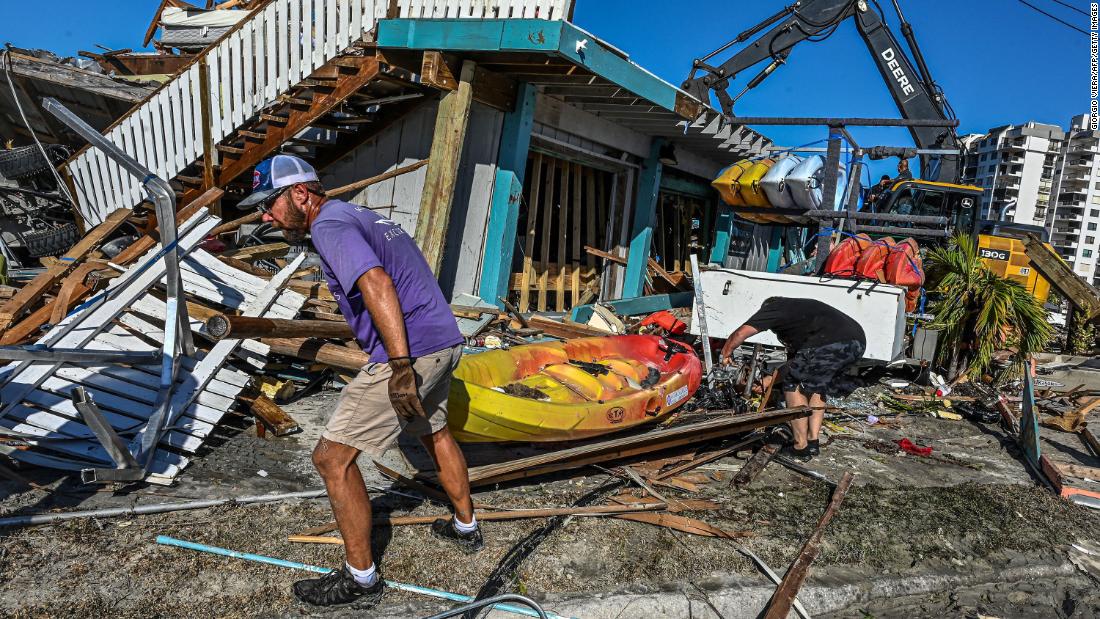

Officials in hardest-hit Lee County, Florida, are facing mounting questions about why the first mandatory evacuations weren’t ordered until a day before Hurricane Ian’s landfall —despite an emergency plan that suggests evacuations should have happened earlier.
Lee County’s evacuation orders also came a day or more after those of neighboring counties to the north.
The county’s Comprehensive Emergency Management Plan states a 10% chance of 6 feet or more of water “would indicate the need” for hurricane evacuations in the most vulnerable areas.
National Hurricane Center advisories, reviewed by CNN, make first mention of “4-7 feet of surge” for that area as early as 11 p.m. ET Sunday — three days before landfall. That level of surge was predicted for an area from Englewood to Bonita Beach – which includes the entire Lee County coast.
By 8 a.m. ET Tuesday, around the time of the first evacuation message, the NHC upped the storm surge forecast to 5-10 feet. And by 11 a.m. ET, the forecast was expanded to 8-12 feet of storm surge for all of Lee County.
The county’s first announcement of mandatory evacuations was not until Tuesday morning. In a news conference around 7 a.m. ET Tuesday, county officials announced mandatory evacuations for the most vulnerable “Zone A” and parts of “Zone B” in the county.
The county also opened its first shelters at 9 a.m. ET Tuesday. Later that day, the county expanded the order to all of Zone B.
Other counties in Ian’s path, such as Hillsborough, Pinellas, Manatee, Sarasota and Charlotte counties spent the day Monday issuing evacuation orders. And even before Hillsborough County issued the formal order, Tampa’s mayor was urging the public to evacuate.
“If you can leave, just leave now, and we will take care of your personal property,” Tampa Mayor Jane Castor told Kate Bolduan on CNN’s At This Hour around 11 a.m. ET Monday.
GOP Sen. Rick Scott, when pressed by CNN’s Dana Bash, declined to assign blame in Lee County, saying, “We’re going to look and find out” if proper evacuation procedures were followed. “I think once we get through this, we do an assessment. What I’ve always tried to do as governor is say, okay, so what did we learn in each one of these.”
Gov. Ron DeSantis and Lee County officials have defended the county’s decision-making process, pointing to a changing forecast track that shifted the worst impacts South closer to landfall.
At a news conference on Monday, the day before the evacuation order was issued, Lee County Manager Roger Desjarlais rejected the notion that Hurricane Ian had been more challenging to plan for than other storms. He said the fact that his county had been within the predicted track of the center of the storm days prior suggested the storm would ultimately shift elsewhere.
“A couple days ago Fort Myers, Lee County was right in the very center of the cone of… uncertainty, and that’s really the best place to be, three or four days out because the storm will never ever behave that way.” Desjarlais said. “So, those variables always exist, and we train for and plan for all the changes in the characteristics of the storm.”
Desjarlais said on Monday that even though the county had not yet issued an evacuation order, residents should feel free to leave.
“If you’re feeling a little nervous about this storm and the effects, it’s okay to go now if you want,” Desjarlais said. “So, if you feel like it and you think it’s a good idea, now is a good time to get on the road and head to a safer part of the state.”
The delays were first reported by The New York Times, and Lee County Commissioner Kevin Ruane pushed back on the Times’ account in an interview with Boris Sanchez on CNN’s New Day Sunday, calling the report “inaccurate” and defending the timetable.
“Unfortunately, people did get complacent,” Ruane said when talking about why people may not have evacuated sooner. “As far as I’m concerned the shelters were open, they had the ability, they had all day Tuesday, they had a good part of Wednesday as the storm was coming down – they had the ability to do so.”
And Fort Myers Mayor Kevin Anderson told CBS’s “Face the Nation” Sunday morning that “warnings for hurricane season start in June. And so, there’s a degree of personal responsibility here. I think the county acted appropriately. The thing is that a certain percentage of people will not heed the warnings regardless.”
CNN’s Keith Allen and Andy Rose contributed to this report
